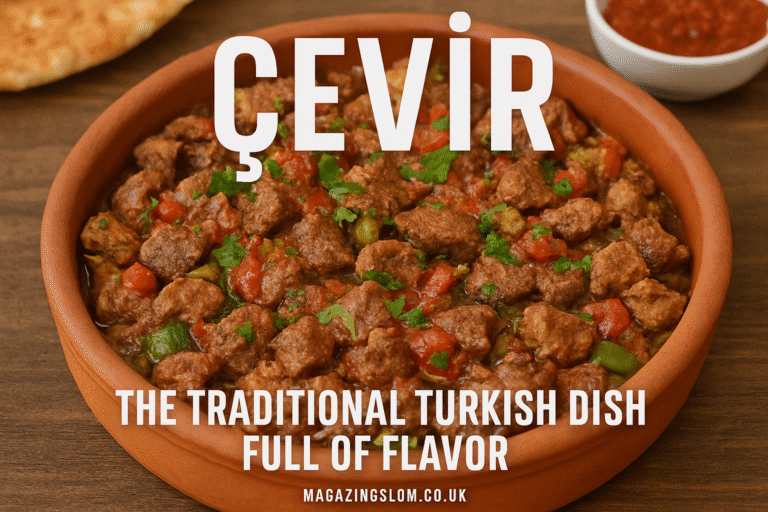The vast and colorful world of Turkish cuisine, few dishes embody the spirit of tradition, hospitality, and bold flavor quite like Ceıvır. Though lesser known outside the regions where it originated, holds a special place in the hearts and kitchens of many Turkish families. With its unique name and unforgettable taste, Ceıvır is beginning to attract international attention from food lovers seeking authentic experiences.
What is Ceıvır?
Ceıvır (pronounced “jeh-eer”) is a hearty meat-based dish that combines marinated meats—usually lamb or beef—with herbs, spices, and sometimes seasonal vegetables, all slow-cooked to perfection. Its name is believed to have originated from a regional dialect or possibly an old Turkish word, hinting at “turning” or “roasting,” which aligns with the method of preparation in many areas.
What makes Ceıvır distinct from other meat dishes in Turkish cuisine is the combination of the marinade, cooking technique, and accompanying side dishes. While kebabs and köfte have their global fame, Ceıvır remains more localized, prepared during special gatherings, festivals, or family feasts.
A Culinary Tradition Rooted in the Regions
Ceıvır is particularly popular in Anatolian regions and parts of southeastern Turkey, where traditional cooking methods like clay ovens (tandır) and open-fire grills are still widely used. In rural areas, preparing Ceıvır is often a community effort, involving the participation of neighbors or family members. The meat is typically marinated for hours, sometimes overnight, in a mix of yogurt, olive oil, garlic, sumac, red pepper flakes, and crushed coriander seeds.
Ceıvır is cooked on vertical spits similar to döner, while in others, it is baked in large ceramic dishes, sealed with dough to retain moisture and flavor. In either method, the result is always the same—tender, flavorful meat that melts in the mouth, with a rich aroma that fills the air.
The Ingredients that Make it Unique
What sets Ceıvır apart is its simplicity and focus on quality ingredients. A typical Ceıvır recipe includes:
-
Meat: Lamb is the traditional choice, although beef or a mix of meats can also be used.
-
Yogurt-based marinade: Adds tenderness and a tangy depth of flavor.
-
Spices: Sumac, red pepper flakes, cumin, black pepper, and bay leaves.
-
Garlic and onion: Essential aromatics that bring a depth of flavor.
-
Olive oil or animal fat: Helps to lock in moisture during cooking.
How Ceıvır is Served
Ceıvır is typically served with traditional flatbreads such as lavash or bazlama, rice pilaf, and a side of fresh salad or pickled vegetables (turşu). In more festive settings, it may be accompanied by yogurt-based sides like cacık or haydari. The meal is usually enjoyed communally, with everyone sharing from the same platter, emphasizing Turkish values of togetherness and hospitality.
For drinks, traditional options like ayran (a yogurt-based beverage) or strong Turkish tea often accompany the meal. In rural celebrations, fermented drinks like şalgam or even homemade fruit wines may also be served.
The Revival of Ceıvır in Modern Turkey
With the rise of interest in traditional foods and slow cooking, Ceıvır is experiencing a revival, particularly among younger Turkish chefs and culinary enthusiasts. Restaurants in Istanbul, İzmir, and Ankara are now featuring Ceıvır on their menus, sometimes with a modern twist—serving it in wraps, pairing it with grilled halloumi, or using it as a topping on flatbreads.
Social media has also played a role in reviving this traditional dish. Turkish food bloggers and YouTube cooks are showcasing regional versions of Ceıvır, inviting their audiences to rediscover forgotten flavors. The dish’s rich visuals—golden meat glistening with marinade and spices—make it ideal for digital storytelling.
A Symbol of Turkish Hospitality
Ceıvır is more than just a delicious meal. It represents Turkish heritage, family bonds, and the enduring importance of hospitality. In many homes, it is not unusual for hosts to spend hours preparing Ceıvır when expecting guests, considering it a gesture of respect and generosity. This attitude reflects the broader Turkish cultural value of misafirperverlik—the art of being a gracious host.
Even during holidays such as Kurban Bayramı (Eid al-Adha), Ceıvır often becomes a centerpiece of celebration, made with fresh meat and served to both family and those in need. It symbolizes sharing not only food but warmth, connection, and cultural pride.
Read More: Lepbound: A Breakthrough in Weight Loss Solutions
Conclusion
As international interest in Turkish cuisine grows beyond the familiar staples, Ceıvır stands out as a hidden gem waiting to be discovered. Its rich flavors, cultural significance, and adaptable nature make it a dish worth celebrating. Whether enjoyed in a village home in Eastern Turkey or a trendy urban restaurant, Ceıvır tells a story—of tradition, taste, and the timeless power of food to bring people together.
If you ever have the opportunity to taste Ceıvır, don’t hesitate. It may not yet be world-famous, but it embodies the soul of Turkish cooking—humble, hearty, and unforgettable.
